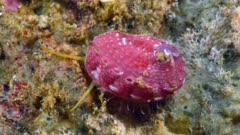
Abalone vary in size from 20 mm (0.79 in) (Haliotis pulcherrima) to 200 mm (7.9 in) while Haliotis rufescens is the largest of the genus at 12 in (30 cm). The shell of abalones is convex, rounded to oval in shape, and may be highly arched or very flattened. The shell of the majority of species has a small, flat spire and two to three whorls. The last whorl, known as the body whorl, is auriform, meaning that the shell resembles an ear, giving rise to the common name "ear shell". Haliotis asinina has a somewhat different shape, as it is more elongated and distended. The shell of Haliotis cracherodii cracherodii is also unusual as it has an ovate form, is imperforate, shows an exserted spire, and has prickly ribs. A mantle cleft in the shell impresses a groove in the shell, in which are the row of holes characteristic of the genus. These holes are respiratory apertures for venting water from the gills and for releasing sperm and eggs into the water column. They make up what is known as the selenizone, which forms as the shell grows. This series of eight to 38 holes is near the anterior margin. Only a small number is generally open. The older holes are gradually sealed up as the shell grows and new holes form. Each species has a typical number of open holes, between four and 10, in the selenizone. An abalone has no operculum. The aperture of the shell is very wide and nacreous. The exterior of the shell is striated and dull. The color of the sh... Learn more about Abalone
View all family groups for: Marine Invertebrate
Abalone Species Videos
View All Abalone Videos
Common Name | Scientific Name | Conservation Status |
Japanese Abalone (11 videos) | Haliotis kamtschatkana | Not Available |
Red Abalone (7 videos) | Haliotis clathrata | Not Available |
